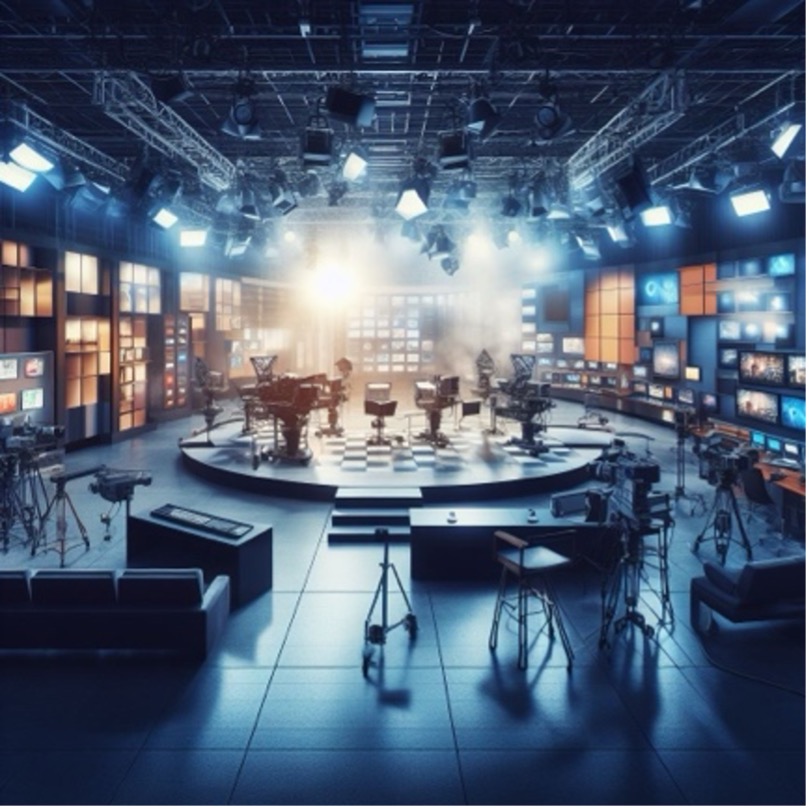Introduction
Prompted and Edited by John Acosta and Generated by ChatGPT 4 and Bing Image Creator unless otherwise noted.

Greetings and welcome, students, to this foundational course on Television Studio Production. This academic journey aims to educate you on the pivotal elements that constitute a fully functioning television studio environment. To flourish in the realm of television production, one must possess a comprehensive understanding of these intricate components. Through this coursework, you will gain valuable insights into the art and science of television production, eventually equipping you with the necessary skills to contribute meaningfully to this captivating medium.
A television studio serves as an architectural and technological hub where video content is meticulously crafted for either live broadcasts or pre-recorded shows. According to Wikipedia, a television studio—also referred to as a television production studio—is “a room where video productions take place, either for the recording of live television to tape or for the acquisition of raw footage for post-production.” This specialized environment houses a range of essential rooms, including but not limited to, control rooms, sound stages, and green rooms, all of which are acoustically isolated to ensure sound fidelity and mitigate operational disruptions. The internal architecture of the studio draws inspiration from its cinematic predecessors but is modified to cater to the distinct requisites of television production. A professional studio often incorporates multiple interconnected spaces, made seamlessly communicative through a ‘talkback’ system or an intercom. This setup enables the efficient allocation of tasks among different members of the production team, thus optimizing the workflow (Wikipedia, n.d.).
In the intricate ecosystem of a television studio, there are key roles and responsibilities that each team member must shoulder to ensure smooth functioning. Some of these include:
1. Executive Producer: Responsible for overseeing the entirety of a television project, from pre-production to post-production, and ensuring its alignment with the defined budget and schedule.
2. Director: The individual who steers the creative vision, calling the shots and guiding the camera operators, actors, and other personnel to produce the envisioned final product.
3. Technical Director: Manages the technical aspects of the production, including the video switcher, and collaborates closely with the director to accomplish the production’s goals.
4. Camera Operators: Individuals who physically operate the cameras under the guidance of the director, capturing the necessary shots for the production.
5. Audio Engineers: Responsible for managing sound quality, from recording dialogues to balancing audio levels.
6. Lighting Technicians: Ensure that the set is adequately lit, fulfilling both artistic and technical criteria.
7. Set Designers: Construct and design the physical environment where the action takes place, according to the requirements of the script and director.
8. Scriptwriter: Develops the textual content for the production, which serves as the blueprint for all other roles.
9. Talent: Refers to the actors or hosts who perform in front of the camera, guided by the director’s vision and the scriptwriter’s words.
10. Floor Manager: Acts as a bridge between the director in the control room and the talent on the studio floor, often providing cues and timekeeping information to ensure smooth operations.
By obtaining a nuanced understanding of these roles and responsibilities, and how they collaborate within the larger framework of a television studio, you will be better equipped to engage in and appreciate the complex yet rewarding field of television studio production.
Reference:
Wikipedia. (n.d.). Television studio. Retrieved from [Television Studio – Wikipedia](https://en.wikipedia.org/wiki/Television_studio)
As we progress through this course, we shall delve deeper into each of these roles, exploring their intricate relationships and their contributions to the production as a whole. Your educational sojourn in this domain will be enriched by both theoretical knowledge and practical exercises, thereby enabling you to develop a robust, multidimensional understanding of television studio production.
Once again, welcome to this enlightening journey. Let us embark together on this path of discovery and academic enrichment.

